


JOSHUA REYNOLDS 1723 -
1792
(G1, G2,
G3a, G3b)
xxxxxThe English
artist Joshua Reynolds produced some 2,000 portraits. A great
admirer of classical antiquity and the masters of the Italian
Renaissance, he espoused the Grand Style, searching after harmony
and beauty and concerned, above all, to give an ideal rather than
a realistic portrayal of his sitters. The elegance and grandeur of
his portraits became exceedingly popular among London's
fashionable society. Such portraits as Commodore
Augustus Keppell and Mrs Siddons as
the Tragic Muse were modelled on Greco-Roman
sculptures or Renaissance works of art, and thus confirmed and
enhanced their standing in society. At the same time, he could
capture the character and the personality of his sitter - as
in his portrait of Lord Heathfield -
and he produced portraits of his many friends, including Samuel
Johnson, Oliver Goldsmith, Edmund Burke, David Garrick and the
American expatriate Benjamin West. He was noted, too, for his delightful and
charming portrayals of fashionable women and innocent children,
such as Lavinia, Countess Spencer, and
the three-year-old Lady Caroline
Scott. In 1768
he was appointed the first president of the
Royal Academy of Arts, and it was here that he gave his annual
lectures on his artistic theories - later published as his Discourses on Art in 1797. He became the
king's principal painter in 1784, and the social standing he
achieved during his career, together with the quality of his work,
did much to raise the status of the artist in society.
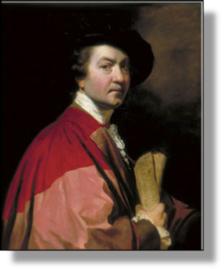 xxxxxThe English artist Joshua Reynolds, one of
the greatest portrait painters of the 18th century, produced some two
thousand portraits. Like Van Dyck before him, and his contemporary and
rival Thomas Gainsborough, the vast majority were studies of the
English aristocracy, though his sitters also included many notable
figures of the day - like the literary giant Samuel Johnson, the
novelist Laurence Sterne, and the celebrities of the stage, David
Garrick and Mrs Siddons. Rendered in the "Grand Manner", a style drawn
from Classical and Renaissance art, they brought portraiture to the
peak of its perfection.
xxxxxThe English artist Joshua Reynolds, one of
the greatest portrait painters of the 18th century, produced some two
thousand portraits. Like Van Dyck before him, and his contemporary and
rival Thomas Gainsborough, the vast majority were studies of the
English aristocracy, though his sitters also included many notable
figures of the day - like the literary giant Samuel Johnson, the
novelist Laurence Sterne, and the celebrities of the stage, David
Garrick and Mrs Siddons. Rendered in the "Grand Manner", a style drawn
from Classical and Renaissance art, they brought portraiture to the
peak of its perfection.
xxxxxReynolds was born in
Plympton, Devon, the son of a clergyman and local schoolmaster. He
went to London at the age of 17 and, after a four-year
apprenticeship, began producing his own portraits, first in Plymouth
and then in London. But anxious to extend his learning, in 1749 he
embarked on a tour of Italy, after being offered a lift to the
Mediterranean by his life-long friend Commodore Augustus
Keppel. His two year visit, which included a long stay in Rome and a
time in Venice, introduced him to Greco-Roman sculpture and the
great masters of the Renaissance, particularly Michelangelo,
Raphael, Leonardo da Vinci and Titian. Out of this experience was
born his polished style and high-minded standards. On his
return to London in 1752, this “Devon man” soon attracted the
attention of London society by the classical elegance of his
portraiture. To this period belongs the portrait of his friend
Keppel, a work which did much to establish his reputation. Within
five years he had 150 sitters a year. Indeed, such was the demand
for his work, the strength of his connections, and the improvement
in his learning, that he soon became the first English painter to
achieve social recognition, thus raising the status of the artist in
society. It was he who made "face painting" – and art in general – a
respectable profession.
xxxxxIn 1766 Reynolds -
now regarded as a man of culture rare - was honoured by being
made a member of the Society of Dilettanti,
an exclusive dining club for gentlemen of refined taste, and this
was followed by public recognition in 1768.
In that year George III founded
the Royal Academy of Arts
to encourage painting, sculpture and architecture, and insisted on
having Reynolds as its first president. The following year he was
knighted and, setting up a school at the academy, began the first of
his famous annual lectures on art, setting out the artistic theories
of his "grand style". In 1781 his love of the Old Masters took him
to Holland and Flanders, where he made a particular study of the
flamboyant Flemish painter Peter Paul Rubens. He was anxious, above
all, to emulate his skill at history painting, but his Death
of Dido, produced that year and regarded as his best work
in this genre, was not an 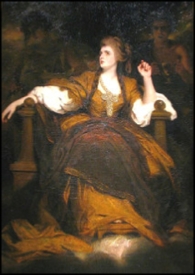 unmitigated
success.
unmitigated
success.
xxxxxHis crowning
glory came in 1784, when he was appointed the King's Principal
Painter. And it was in this year, appropriately, that he produced
what many consider to be his masterpiece, the classical portrait of
Sarah Siddons as the
Tragic Muse. Needless to say, his prominent position in
society made him the centre of a wide circle of friends,
particularly in the worlds of literature and the theatre. He was a
close friend of Dr Johnson - with whom he founded the Literary
Club - and of Oliver Goldsmith, Laurence Sterne, Edmund Burke,
David Garrick and the artist Benjamin West, the American expatriate
who succeeded him as president of the Academy.
xxxxxReynold's style and
artistic aims were clearly defined in his influential book Discourses
on Art, published collectively in 1797. This work, based on
the annual lectures he gave at the Royal Academy, laid great stress
on the value of tradition, and the restrictions as well as the
values it imposed. The artist was obliged to uph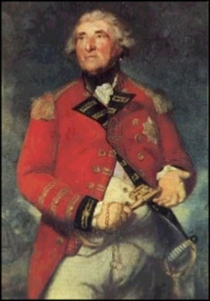 old
the principles of classical beauty, and this meant representing the
ideal, not the realistic. Thus his "Grand Manner" produced an air of
eminence and dignity, as can clearly be seen in his Mrs
Siddons as the Tragic Muse (illustrated
above) - where, incidentally, her
gesture was taken directly from Michelangelo's Isaiah on the Sistine
Ceiling. In like manner, the poses he gave to many of his "sitters"
were taken directly from classical antiquity, as were the background
props, such as arches, columns and heavy drapery. Thus his friend
Augustus Keppel is modelled on the Apollo
Belvedere, a well-known statue; his Lieutenant
Colonel Sir Banastre Tarleton has the pose of a particular
Roman warrior; and his Three Ladies Adorning a
Term (Statue) of Hymen were composed with the three graces
in mind. Such measures were employed as a deliberate means of
enhancing the social standing of his sitters. Likewise, he was
prepared to improve natural deficiencies, facial or bodily, in order
to do justice to the noble person within.
old
the principles of classical beauty, and this meant representing the
ideal, not the realistic. Thus his "Grand Manner" produced an air of
eminence and dignity, as can clearly be seen in his Mrs
Siddons as the Tragic Muse (illustrated
above) - where, incidentally, her
gesture was taken directly from Michelangelo's Isaiah on the Sistine
Ceiling. In like manner, the poses he gave to many of his "sitters"
were taken directly from classical antiquity, as were the background
props, such as arches, columns and heavy drapery. Thus his friend
Augustus Keppel is modelled on the Apollo
Belvedere, a well-known statue; his Lieutenant
Colonel Sir Banastre Tarleton has the pose of a particular
Roman warrior; and his Three Ladies Adorning a
Term (Statue) of Hymen were composed with the three graces
in mind. Such measures were employed as a deliberate means of
enhancing the social standing of his sitters. Likewise, he was
prepared to improve natural deficiencies, facial or bodily, in order
to do justice to the noble person within.
xxxxxThis said, he was fully
capable of capturing the character and individuality of his sitter,
as can be seen in his brilliant portrait of Lord
Heathfield (detail illustrated
above), the man who was the governor of
the fortress during the Great Siege of Gibraltar,
beginning in 1779. And alongside this
formalised, idealistic style went close studies of his many friends
- like that of Samuel Johnson -, and some delightful,
gentle portraits of children, including three-year-old Lady Caroline Scott, The
Brummel Children (one of whom became the Regency dandy Beau
Brummel), and The Age of Innocence and
the Heads of Angels (illustrated), both in the Tate Gallery, London.
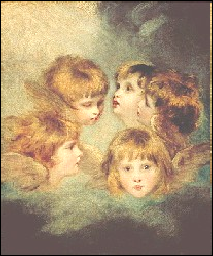
xxxxxReynold's output was quite
enormous and, in his early days, he employed assistants, such as
"drapery specialists", to complete the costume and background of
each portrait. On occasions he would have as many as six sittings in
a day. In later years, however, when he confined his portraits to
head and shoulders - like the charming and gentle Lavinia,
Countess Spencer of 1782 - he painted the entire work
himself, and his style became more relaxed. His self-portrait
above shows him dressed in the robes of a Doctor of Civil Law, an
honorary degree conferred upon him by Oxford University. The
composition owes much to Rembrandt.
xxxxxThe portraits below (left
to right) are: Lady Caroline Worsley, John Parker and his sister Theresa,
A Strawberry Girl, Lavinia,
Countess Spencer, and the English music critic Charles
Burney.
Acknowledgements
Reynolds: Self-Portrait
(detail) – Uffizi Gallery, Florence; Sarah Siddons as Tragic Muse
– Huntington Gallery, San Marino, CA; Lord Heathfield (detail) –
National Gallery, London; Heads of Angels – Tate Gallery, London;
Lady Caroline Worsley (detail) – Harewood House, Yorkshire,
England; John and Theresa Parker (detail) – Saltram House, near
Plymouth, Devon; The Strawberry Girl – Wallace Collection, London;
Lavina, Countess Spencer – The Spencer Collection, Althrop,
Northamptonshire; Charles Burney – National Portrait Gallery,
London; Omai – Castle Howard Collection, Yorkshire. Kauffmann: Self-Portrait – Hermitage Museum, St.
Petersburg; Winckelman – Kunsthaus Art Gallery, Zurich; The Legend
of Cupid and Psyche – Museo Civico Rivoltello, Trieste; Garrick –
Burghley House Art Collection, Lincolnshire. Fuseli:
Nightmare – Institute of Arts, Detroit; Samuel appears to Saul –
Kunsthaus Art Gallery, Zurich; Silence – Kunsthaus Art Gallery,
Zurich; Self-Portrait – Victoria and Albert Museum, London;
Weird sisters/witches – Picture Gallery, Royal Shakespeare
Theatre, Stratford-on-Avon. Zoffany:
The Tribuna at Uffizi – Royal Collection, UK; Self-Portrait –
The Etruscan Academy Museum, Cortona, Italy; The Royal Family –
Royal Collection, UK; Figures and Elephants amid Banya Trees,
India – Yale Center for British Art, New Haven, CT. Wright: Experiment with an Air Pump – National Gallery,
London; Self-Portrait – National Gallery of Victoria,
Melbourne; Landscape with rainbow – Derby Museum and Art Gallery,
England; Caenarvon Castle by Moonlight – City Art Gallery,
Manchester, England; Sarah and Ann Haden – Worcester Art Museum,
Massachusetts, USA; Erasmus Darwin – Derby Museum and Art Gallery,
England.
G3a-1760-1783-G3a-1760-1783-G3a-1760-1783-G3a-1760-1783-G3a-1760-1783-G3a
Including:
Angelica Kauffmann,
Henry Fuseli, Johann
Zoffany and
Joseph Wright


xxxxxThe quality
and versatility of his work were greatly admired. His rival Thomas
Gainsborough complained "How various he is!", and the 19th century
art critic John Ruskin regarded him as the "prince of portrait
painters". But he was not without his critics. The English artist
William Blake strongly
opposed rules and regulations in art, and the Pre-Raphaelite
Brotherhood condemned his techniques and dubbed him "Sir Sloshua".
Reynold's eyesight began to fail in 1789 and he made no
appointments after July of that year. When he died in London three
years later he was buried at St. Paul's Cathedral amid the pomp
usually reserved for royalty and national heroes. His friend
Edmund Burke described the funeral as the most splendid ever
accorded a British artist.
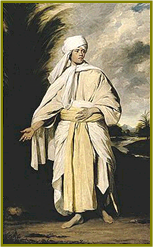
xxxxxIncidentally, Reynolds tended to experiment with his painting
materials. Unfortunately, in some of his pictures he used bitumen
and other unusual pigments, and this often led to a premature
fading of the colours or a fine cracking of the surface. In some
of these works, deterioration was noticeable during his lifetime,
particularly in the flesh tones. ……
xxxxx…… Captain Cook’s second tour to the South Seas returned
with a Tahitian named Omai. A dignified man with excellent
manners, he proved an overnight sensation. He was presented to the
King and Queen, wined and dined in London’s high society, and met,
amongst others, Samuel Johnson and Fanny Burney. He returned to
his homeland in 1776, but not before Reynolds had painted his
portrait and captured something of Rousseau’s “noble savage”.
xxxxxThe Swiss
painter Angelica Kauffmann
(1741-1807) was a close friend of Joshua Reynolds, and, like
him, a founder member of the Royal Academy of Arts. She was born
in Chur, Switzerland, and, as a child, lived for a short time in
Italy. She returned there in 1763, and it was then that she met
the art historian Johann Winckelmann and painted his portrait.
That meeting doubtless played a part in fashioning her interest in
neo-classicism, though there was always a nuance of the
Rococo style about her work, probably the influence of François
Boucher. Thus whilst her figures were given Greco-Roman
poses. and there were plenty of classical allusions - as in
Reynold's portraits - her style had a softness and delicacy
of touch. Shown here are (left to right): Self-Portrait,
the German art historian Johann Winckelmann,
The Legend of Cupid and Psyche, and the
actor David Garrick.
xxxxxAfter studying in Italy,
where she met the art historian Johann Winckelmann, the Swiss-born
artist Angelica Kauffmann
(1741-1807) settled in London in 1766. A close friend of Joshua
Reynolds, her portraits and paintings became very popular. Many of
her historical and mythological scenes adorned the walls of country
houses, and she did a great deal of decorative work for the Scottish
interior designer Robert Adam.
Her work showed the influence of neo-classicism, but contained
a Rococo delicacy and softness. She married the Venetian painter
Antonio Zucchi (1726-1795) and went to live in Rome in 1782.

xxxxxShe stayed
three years in Italy, visiting Rome, Bologna and Venice, and then
settled in London in 1766 where, with Reynold's assistance, she soon
became well known for her portraits and her historical, pastoral
and mythological scenes - many painted to adorn the walls of
country houses. She produced more than 500 paintings, and her
graceful style proved immensely popular. She also provided a large
amount of decorative work for the Scottish interior designer
Robert Adam, and
this was used in
wall and ceiling panels, and to embellish furniture. It is upon
this decoration that her fame now mainly rests. Inx1781
she married the Venetian painter Antonio
Zucchi (1726-1795), and the
following year they went to live in Rome.
xxxxxAnother
Swiss-born artist at this time was Henry
Fuseli (1741-1825). He moved to
London in 1764, but was advised by Josuha Reynolds to study in
Italy. There, he was particularly influenced by the works of
Michelangelo, but on his return he chose highly imaginative
subjects, some full of horror and foreboding, and others centred
on paintings and drawings of distorted female nudes. His The
Nightmare, produced in 1781, caused a sensation and
brought him fame. A writer of ability, he also translated a major
work by the art historian Johann Winckelmann, and, as a member of
the Royal Academy, was appointed its keeper in 1804. As we shall
see (1794 G3b)
his work influenced his friend, the English artist and poet
William Blake.
xxxxxAnother Swiss-born artist at
this time was Henry Fuseli
(1741-1825), a man noted for his exotic and original
paintings. He emigrated to England in 1764, two years before
Kauffmann arrived in London, and, on the advice of Reynolds, went
to study in Italy. Here, like Reynolds, he came to admire the
works of Michelangelo.
This was to have some influence on his style, but certainly not on
his subject matter. On his return, many of his paintings revolved
around highly imaginative works which were full of horror and
foreboding, a number of which included scenes
from Milton and Shakespeare. As such these paintings had much in
keeping with the frightening stories of Gothic novelists like Horace Walpole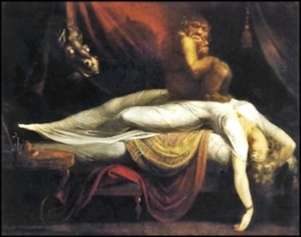 ,
Ann Radcliffe and Matthew Gregory Lewis. Their tales of terror and
the supernatural, together with Fuseli's macabre productions,
marked the beginning of one aspect of the English romantic
movement.
,
Ann Radcliffe and Matthew Gregory Lewis. Their tales of terror and
the supernatural, together with Fuseli's macabre productions,
marked the beginning of one aspect of the English romantic
movement.
xxxxxFuseli is
best remembered today for his disquieting fantasy The
Nightmare (illustrated), painted in 1781. This caused a sensation and brought
him instant fame, but he also revelled in producing distorted
pictures and drawings of female nudes, some wearing oversized head-dresses.
Apart from his interest in painting, he was also a talented writer,
and was responsible for the translation of Reflections
on the Painting and Sculpture of the
Greeks, the first major work of the German art critic
Johann Winckelmann. He was elected a full member of the Royal
Academy in 1790, where he became professor of painting over a number
of years, and was appointed keeper of the Academy in 1804. As we
shall see (1794 G3b),
his work was to have a marked influence upon his younger
contemporary and friend, the visionary English artist and poet
William Blake. Shown here (left to right) are: Samuel
appearing to Saul, a disturbing work entitled Silence,
a Self-Portrait, and The
Weird Sisters.

xxxxxAnother continental artist
who worked in England during this period was the German-born Johann Zoffany (1733-1810).
He lived in London from 1758, painting scenes from theatre
productions, and producing elegant portraits of the royal family and
the aristocracy. It was during a stay in Italy, financed by the
king, that he painted The Tribuna of the Uffizi,
depicting some of the art treasures of this Florence gallery. A
founder member of the Royal Academy, he produced The
Academicians of the Royal Academy in 1772, a scene which
included portraits of himself and Joshua Reynolds. He spent some
time in India during the 1780s, working as a portrait artist.
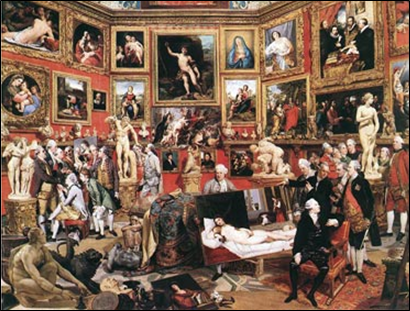 xxxxxAnother continental artist who spent much of his
working life in England was the German-born painter Johann Zoffany (1733-1810).
He arrived in London around 1758 and quickly gained a reputation
for his elaborate conversation pieces (portraits of people in
their normal surroundings) and for his scenes from stage
productions, particularly
those including the famous English actor David Garrick. For the
king, who greatly admired his elegant style and technical skill,
he painted many portraits, including Queen
Charlotte with Her Sons, the Prince of Wales and the Duke of
York, completed about 1794.
xxxxxAnother continental artist who spent much of his
working life in England was the German-born painter Johann Zoffany (1733-1810).
He arrived in London around 1758 and quickly gained a reputation
for his elaborate conversation pieces (portraits of people in
their normal surroundings) and for his scenes from stage
productions, particularly
those including the famous English actor David Garrick. For the
king, who greatly admired his elegant style and technical skill,
he painted many portraits, including Queen
Charlotte with Her Sons, the Prince of Wales and the Duke of
York, completed about 1794.
xxxxxGiven
financial help from the king, he went to work in Italy in 1772,
and it was here in 1780 that he produced his celebrated painting The Tribuna of the Uffizi, a scene depicting
a group of connoisseurs and students admiring some of the art
treasures in the Uffizi Gallery in Florence (now in Windsor Castle
and illustrated above). He also spent some time in India during
the 1780s, working as a portrait artist. A founder member of the
Royal Academy in 1768, his The Academicians of
the Royal Academy, produced four years later, included
portraits of himself and Joshua Reynolds (also in Windsor Castle).
Among his works was a highly romanticised version of the murder of
the English explorer Captain James Cook in 1779. Illustrated below
are: A Self-Portrait, The
British Royal Family, and Figures and
Elephants amid Banya Trees, India.

xxxxx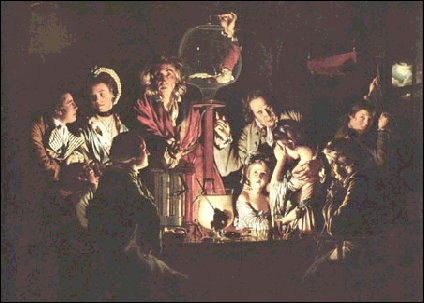 It
was in this year (1768)
that the English artist Joseph Wright (1734-97) painted his famous and highly
original The Air Pump, one of a number
of his works depicting the advances being made in technical
knowledge in the age of the Industrial Revolution. A family group,
including two distressed children, watch an experiment in which
air is pumped out of a glass container, slowly suffocating the
bird trapped within (illustrated). The demonstrator is about to open a valve to admit
air and revive the bird, but fears he has left it too late. Among
other paintings of this kind, produced during the 1760s and early
1770s, were The Orrery,
The Alchymist, and themes of labour such
as The Iron Forge
and The Blacksmith’s Shop. These works
above all were remarkable for their dramatic lighting effects in
which the subject of the piece was lit by a strong artificial light
- fire or candlelight - in an otherwise darkened room.
These “candle-lights”, as they were called, were widely
circulated as engravings and established his reputation.
It
was in this year (1768)
that the English artist Joseph Wright (1734-97) painted his famous and highly
original The Air Pump, one of a number
of his works depicting the advances being made in technical
knowledge in the age of the Industrial Revolution. A family group,
including two distressed children, watch an experiment in which
air is pumped out of a glass container, slowly suffocating the
bird trapped within (illustrated). The demonstrator is about to open a valve to admit
air and revive the bird, but fears he has left it too late. Among
other paintings of this kind, produced during the 1760s and early
1770s, were The Orrery,
The Alchymist, and themes of labour such
as The Iron Forge
and The Blacksmith’s Shop. These works
above all were remarkable for their dramatic lighting effects in
which the subject of the piece was lit by a strong artificial light
- fire or candlelight - in an otherwise darkened room.
These “candle-lights”, as they were called, were widely
circulated as engravings and established his reputation.
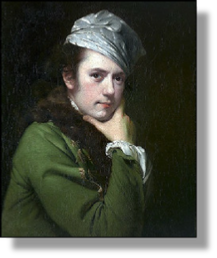
xxxxxWright was
born in Derby, the city in northern England which virtually gave
birth to the Industrial Revolution. Apart from his paintings of
technical innovations - in which he was very much a pioneer -
he produced a number of portraits, particularly of northern
industrialists and local gentry. As a result, he numbered among
his friends the cotton magnates Sir Richard Arkwright and Samuel
Crompton, the pottery manufacturer Sir Josiah Wedgwood, and the
English physician Erasmus Darwin. His brilliant portraiture was
noted for its down-to-earth realism, and the avoidance
of conventional pose and setting. This self-portrait dates
from around 1770.
xxxxxHe was also
an accomplished landscape artist. During a visit to Italy in the
years 1773-1775 (his only visit abroad) he produced several
pictures of Vesuvius erupting, and painted the annual firework
display at the Castel Sant’ Angelo in Rome. Such subjects,
together with moonlit grottoes, gave him ample scope to indulge in
his obsession with lighting effects. On his return from Italy he
gave much time over to literary themes, based on legend or
classical myth, or illustrating works by such writers as
Shakespeare, Milton and Sterne. Towards the end of his life he
produced small landscapes of the Lake District, visited in 1793
and 1794. In some respects his style recalls the landscapes of
Claude Lorrain and Richard Wilson. Shown below are: Landscape
with Rainbow, Caernarvon Castle by
Moonlight, and Sarah and Ann Haden.
xxxxxThe English artist Joseph Wright of Derby (1734-97)
is best known for his works depicting the technical advances being
made in the Industrial Revolution - such as The
Air Pump and The Orrery. And
these, together with his labour themes, like The
Iron Forge, and his landscapes, such as Vesuvius
in eruption, gave him the scope to display his remarkable
lighting effects. The subject of his painting was often illuminated
by natural or artificial light, highlighted by the surrounding
darkness. But Wright was also a brilliant portrait artist, thereby
getting to know men like Richard Arkwright, Samuel Crompton, Josiah
Wedgwood, and Erasmus Darwin (grandfather of Charles Darwin), but,
after 1775, he gave much time over to landscapes. He painted
legendary and mythological scenes, or took themes from works by
Shakespeare, Milton and Sterne. Here, his style recalled the
landscapes of Lorrain and Wilson. He spent most of his life in
Derby, but he did work for a time in Liverpool and Bath, and he did
exhibit in London.

xxxxxWright
spent most of his life in Derby - where he became known as
“Wright of Derby” - , but he worked for some years in both
Liverpool and Bath, and he sent paintings to be exhibited in
London on a fairly regular basis. In 1785 he put on a one-man
show of his work in Liverpool.
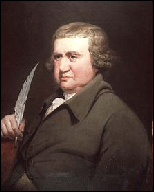
xxxxxIncidentally, hisxclose friend Erasmus Darwin (1731-1802)
was not only an eminent physician. A man with radical views, he
wrote on a variety of subjects. His works included The
Botanic Garden of 1795, and Zoonomia
a year later, a treatise in which he advanced ideas on evolution
similar to those put forward by the French naturalist Jean-Baptiste
de Lamarck. Known for his modern approach towards scientific
matters, he was the grandfather of the famous Charles Darwin.






 xxxxxThe English artist Joshua Reynolds, one of
the greatest portrait painters of the 18th century, produced some two
thousand portraits. Like Van Dyck before him, and his contemporary and
rival Thomas Gainsborough, the vast majority were studies of the
English aristocracy, though his sitters also included many notable
figures of the day -
xxxxxThe English artist Joshua Reynolds, one of
the greatest portrait painters of the 18th century, produced some two
thousand portraits. Like Van Dyck before him, and his contemporary and
rival Thomas Gainsborough, the vast majority were studies of the
English aristocracy, though his sitters also included many notable
figures of the day - unmitigated
success.
unmitigated
success. old
the principles of classical beauty, and this meant representing the
ideal, not the realistic. Thus his "Grand Manner" produced an air of
eminence and dignity, as can clearly be seen in his Mrs
Siddons as the Tragic Muse (illustrated
above) -
old
the principles of classical beauty, and this meant representing the
ideal, not the realistic. Thus his "Grand Manner" produced an air of
eminence and dignity, as can clearly be seen in his Mrs
Siddons as the Tragic Muse (illustrated
above) -




 ,
Ann Radcliffe and Matthew Gregory Lewis. Their tales of terror and
the supernatural, together with Fuseli's macabre productions,
marked the beginning of one aspect of the English romantic
movement.
,
Ann Radcliffe and Matthew Gregory Lewis. Their tales of terror and
the supernatural, together with Fuseli's macabre productions,
marked the beginning of one aspect of the English romantic
movement. 
 xxxxxAnother continental artist who spent much of his
working life in England was the German-
xxxxxAnother continental artist who spent much of his
working life in England was the German-
 It
was in this year (1768)
that the English artist Joseph Wright (1734-
It
was in this year (1768)
that the English artist Joseph Wright (1734-




